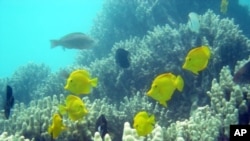New research suggests an overload of carbon dioxide in the oceans is posing a serious threat to marine life, food security and tourism.
While most CO2 emissions from automobiles, buildings and factories go into the atmosphere, one-third ends up in the oceans, changing ocean chemistry and making seawater more acid.
A study in Nature Climate Change tracks ocean acidity over 21,000 years of climate history. Tobias Friedrich, co-author and post-doctoral fellow at the University of Hawaii International Pacific Research Center says the record shows natural increases in CO2 concentrations in the atmosphere over time and differences from region to region.
“This, of course, also had an effect on acidity levels in the ocean, and then (we) compared this naturally occurring increase in atmospheric carbon dioxide concentrations with man-man emissions over the last two-hundred years.”
The scientists used computer models with data from ice and ocean sediment cores to simulate ocean conditions, back to the ice age and forward to the end of the 21st century.
When Earth started to warm 17,000 years ago, at the end of the last ice age, atmospheric CO2 began to rise. Over the next 6,000 years, it grew from 190 parts per million to 280 parts per million.
Marine systems had time to adjust.
Axel Timmerman is a professor of oceanography at the University of Hawaii International Pacific Research Center and co-author of the study. He says the past 200 years paint a much different picture.
“Starting with the pre-industrial revolution, anthropogenic emissions increased so much that the oceans suddenly started to take up huge amounts of carbon.”
CO2 concentration in the atmosphere now stands at 392 parts per million. Timmerman says the study, which also includes 30 years of observational data, finds dangerously high levels of ocean acidification in certain regions.
“Such as the coral triangle, the western tropic of the Pacific and the Caribbean exceed the naturally occurring levels by factors of up to thirty in a few spots.”
Timmerman says this is happening at an accelerated pace. “The rate of change is about two orders of magnitude faster than what occurred during the last glacial period about 20 to 15,000 years ago.”
While ocean acidification could have been detected much earlier, scientists only began to monitor it a few decades ago. As seawater becomes more acid, carbonate - the mineral many sehllfish and corals use to form their shells and skeletons - is reduced.
Coupled with pollution and warming temperatures, it is a serious threat to ocean life. Axel Timmerman says his study gives decision-makers another tool for assessing that threat and evaluating the steps they can take to mitigate it.







